So my nephew just got his first car and I'm helping him clean it up. He has a bit of paint transferred from an apparent fender bender on one of the fenders. Where do I start on this? We're not shooting for anything near perfection... just clean it up and polish a bit. Any help appreciated.
Navigation
Install the app
How to install the app on iOS
Follow along with the video below to see how to install our site as a web app on your home screen.
Note: This feature may not be available in some browsers.
More options
Style variation
You are using an out of date browser. It may not display this or other websites correctly.
You should upgrade or use an alternative browser.
You should upgrade or use an alternative browser.
How to remove paint transferred from fender bender
- Thread starter jdgamble
- Start date
Bhoppy1216
New member
- Aug 12, 2017
- 40
- 0
Actually if you go on you tube and look up ChrisFix Paint Transfer he has a really cool shorter video on how to quickly remove minor paint transfer. It is nothing to time consuming either, and might be educational to your nephew. He takes some white paint off his pristine red Corvette.
Mike Phillips
Active member
- Dec 5, 2022
- 51,004
- 6
Just to chime in...
Most of the time when I see someone tell others how to remove paint transfer they recommend machine buffing the affected area.
My experience is this can lead to burning through the paint or "twisting" the paint in the process.
Why?
Because in most cases, when a fender or bumper, even door on your car has been rubbed against hard by some other object and had paint transferred onto your car's body panels the paint transferred is IMPACTED incredibly hard onto the surface to the point that it is functionally now a part of the impacted paint.
Buffing to remove it will require time and when you only buff a SMALL area for extended time you heat up the surface and this is what leads to problems or like the saying goes, turning a mole hill into a mountain.
Instead, the safe way it to go old school and abrade off the impacted paint by hand using a quality compound and either terry cloth or microfiber and the reason for cloth is you use the cloth as a form of abrasive to work with the abrasives in the compound.
The rubbing of a compound against the transferred paint will gently remove the transferred paint without creating heat to the rest of the underlying paint. (unless you have the muscle and hand speed of Superman).
This approach WILL likely leave marring on the underlying good paint but then all you do us use the normal protocol any of us would use to remove swirls, scratches, oxidation or water spots from paint and this will remove the marring. The normal protocol to clean up any marring would of course be using ANY orbital polisher with a quality compound or medium cut polish with a foam pad.
After removing the marring, then apply whatever you're using for an LSP.
LSP = Last Step Product
An LSP can be a traditional car wax, a synthetic paint sealant or a ceramic coating.
Hope this helps...

Most of the time when I see someone tell others how to remove paint transfer they recommend machine buffing the affected area.
My experience is this can lead to burning through the paint or "twisting" the paint in the process.
Why?
Because in most cases, when a fender or bumper, even door on your car has been rubbed against hard by some other object and had paint transferred onto your car's body panels the paint transferred is IMPACTED incredibly hard onto the surface to the point that it is functionally now a part of the impacted paint.
Buffing to remove it will require time and when you only buff a SMALL area for extended time you heat up the surface and this is what leads to problems or like the saying goes, turning a mole hill into a mountain.
Instead, the safe way it to go old school and abrade off the impacted paint by hand using a quality compound and either terry cloth or microfiber and the reason for cloth is you use the cloth as a form of abrasive to work with the abrasives in the compound.
The rubbing of a compound against the transferred paint will gently remove the transferred paint without creating heat to the rest of the underlying paint. (unless you have the muscle and hand speed of Superman).
This approach WILL likely leave marring on the underlying good paint but then all you do us use the normal protocol any of us would use to remove swirls, scratches, oxidation or water spots from paint and this will remove the marring. The normal protocol to clean up any marring would of course be using ANY orbital polisher with a quality compound or medium cut polish with a foam pad.
After removing the marring, then apply whatever you're using for an LSP.
LSP = Last Step Product
An LSP can be a traditional car wax, a synthetic paint sealant or a ceramic coating.
Hope this helps...
Mike Phillips
Active member
- Dec 5, 2022
- 51,004
- 6
Here's an article I wrote with pictures 7 years ago on this topic....
How How To remove Paint Transfer off your car's paint
At the time I wrote it the Pinnacle Advanced Compound did not exist so I showed using the least aggressive method to tackle this type of work and that was to use a non-abrasive paint cleaner.
I later added the compound to the write-up.
In the real world I wouldn't mess around with a non-abrasive paint cleaner but would start out with a quality compound that uses great abrasive technology simply to get in and get the job done quickly.
How How To remove Paint Transfer off your car's paint
How To Remove Paint Transfer
Paint Transfer is a term used to describe when the paint off of some other object is transferred onto you car's finish usually by some kind of accident.
My friend Rob is a Fitness Instructor at the gym I work out at and someone, somehow sideswiped his 2006 Ford Mustang GT and in so doing took off is side mirror and transferred some white paint onto his car's finish along with instilling some marring and scratches.


Luckily the damage wasn't worse!
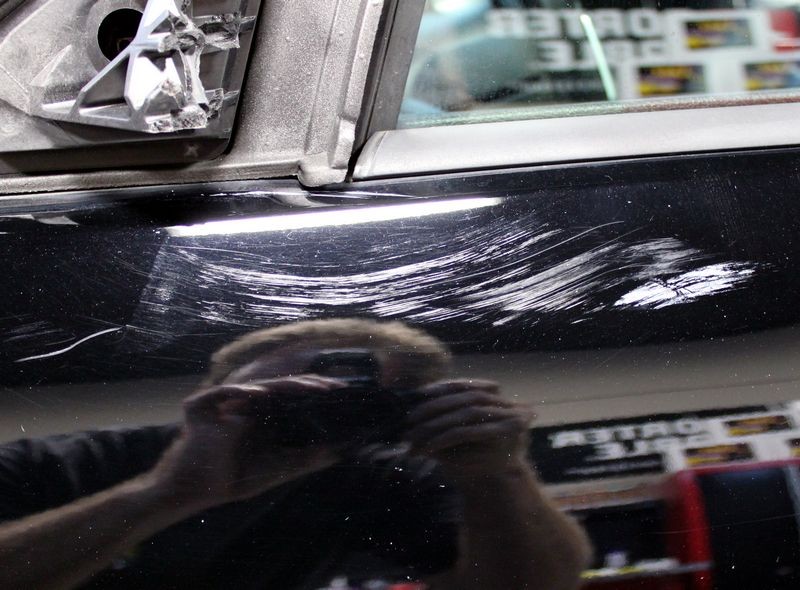
Here's how you can remove paint transfer by hand using a light paint cleaner. For this example I'll use Pinnacle Paintwork Cleansing Lotion.
Pinnacle Paintwork Cleansing Lotion non-abrasive, it is designed to safely take off old wax, embedded road grime and pollution that washing will not remove. It prepares the surface for waxing by creating a clean, smooth, highly-reflective surface.
This is a very mild polish and because it's non-abrasive I'm going to apply and work it with a microfiber applicator pad, in this situation were using the nap of the microfiber as our abrasive along with the lubrication and cleaning ability of Pinnacle Paintwork Cleansing Lotion to gently remove the offending paint.
If you find Pinnacle Paintwork Cleansing Lotion is not aggressive enough, you can use Pinnacle Advanced Compound. This is a hi tech compound that uses the latest in abrasive technology and while it will finish down like a polish it's a good idea to follow it with a less aggressive polish like the Pinnacle Advanced Finishing Polish.
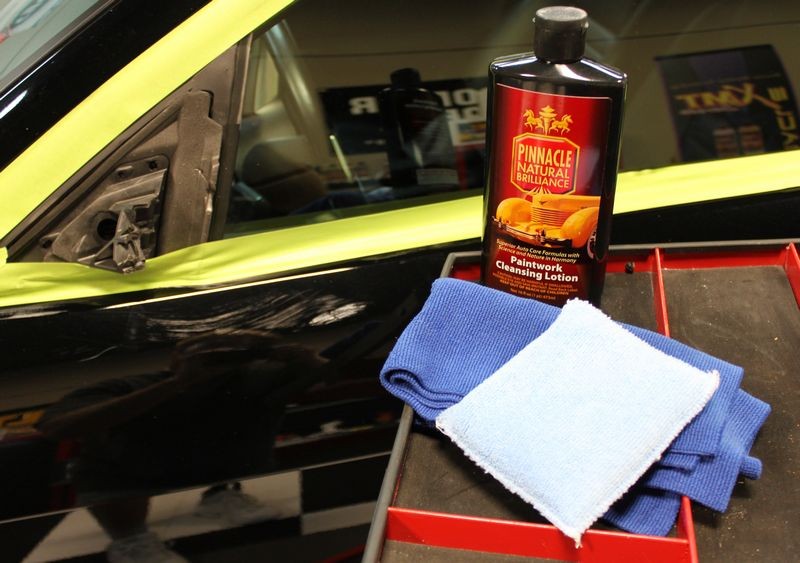
Place a small amount of Paintwork Cleansing Lotion onto the face of your applicator pad...
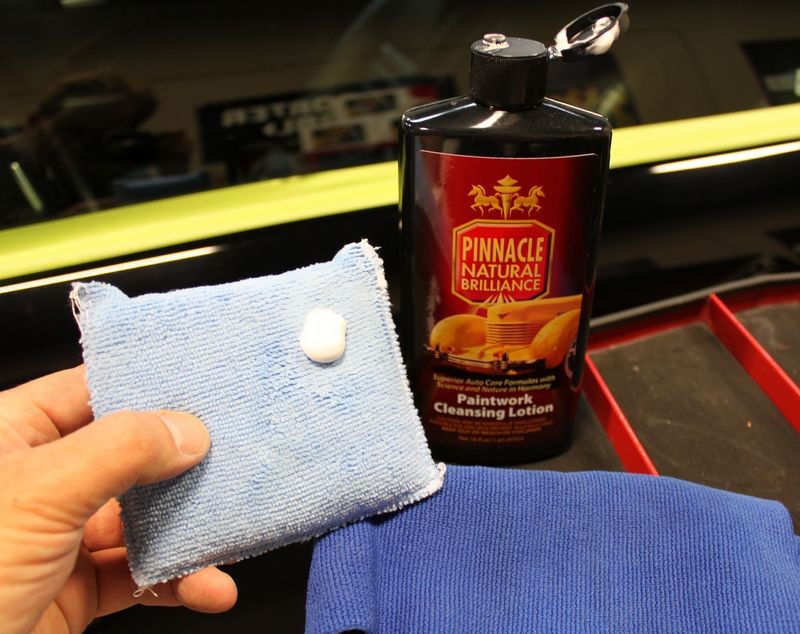
Next work the polish and applicator against the transferred paint putting a little passion behind the pad but don't push too hard or you could instill fingermarks just from the concentrated pressure from your fingertips...
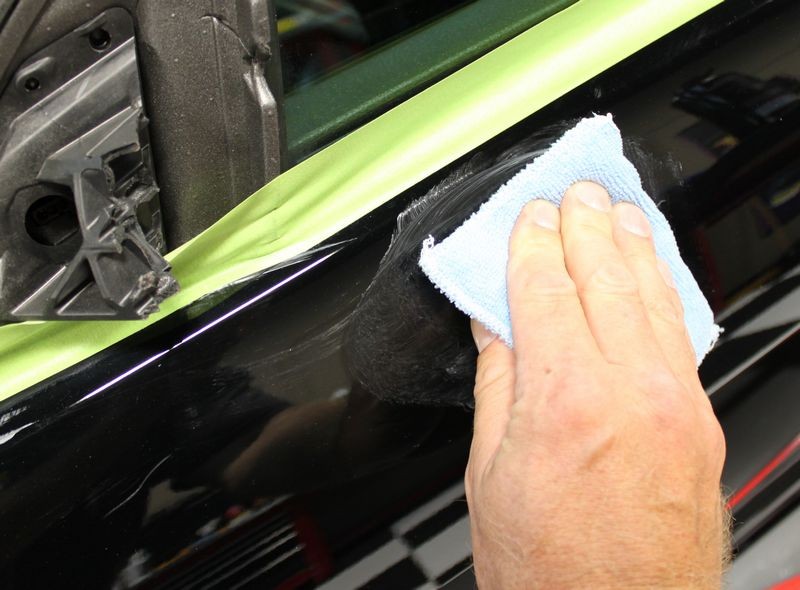
After working the product for about a minute, stop and inspect to check your progress.. You can see most of the paint transfer has been removed but not 100% of it. Sometimes you many need to repeat the process a few times to completely remove the paint transfer.

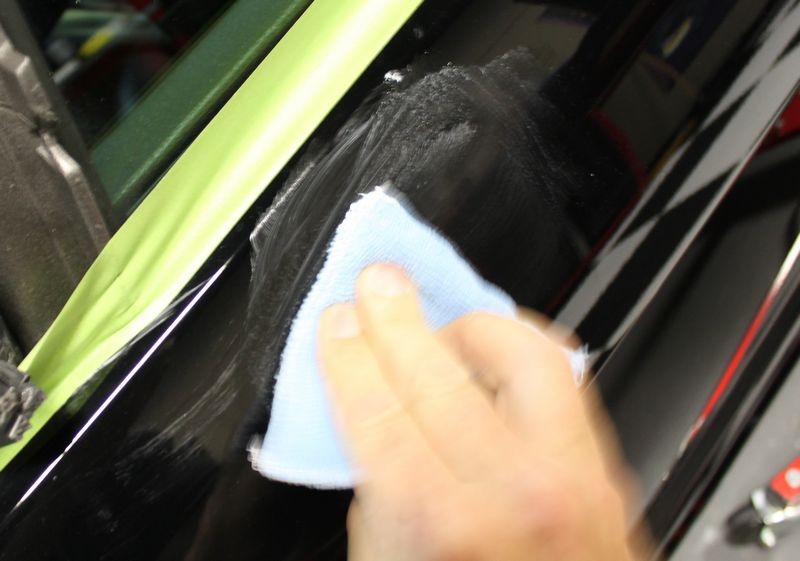
After you've successfully removed the paint transfer you can apply a protective coat of wax or paint sealant or like I've done here, machine polished the paint and then machine waxed the paint.

Looks as good as new and now Rob's going to have the mirror replaced.
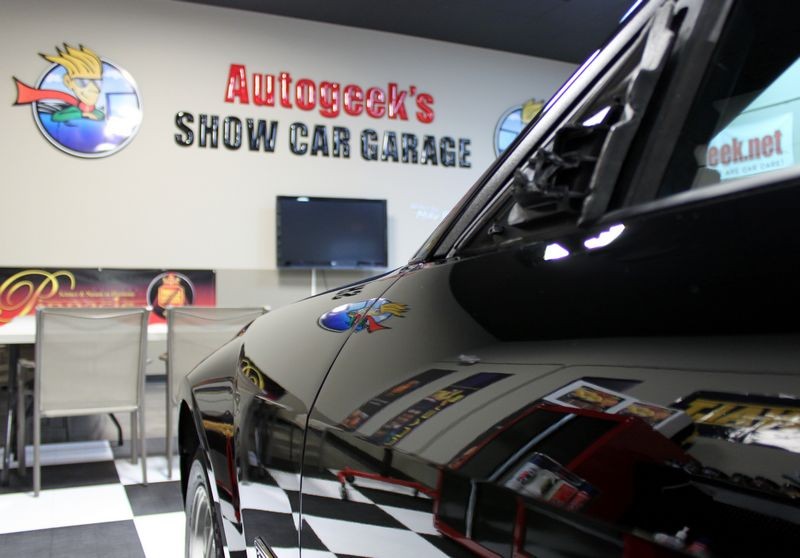
Thanks Rob for bringing your car to Autogeek's Show Car Garage!
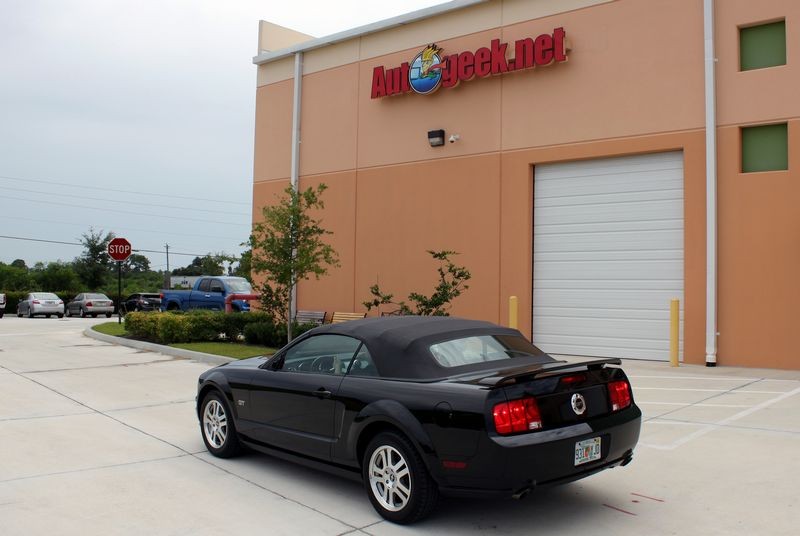
Products Used
Pinnacle Paintwork Cleansing Lotion
Cobra Indigo Microfiber Polishing Cloth
Cobra Microfiber Applicator Pads
Pinnacle Liquid Souveran Car Wax
Further Resources
How to use a hand applied abrasive polish or paint cleaner by hand

How How To remove Paint Transfer off your car's paint
At the time I wrote it the Pinnacle Advanced Compound did not exist so I showed using the least aggressive method to tackle this type of work and that was to use a non-abrasive paint cleaner.
I later added the compound to the write-up.
In the real world I wouldn't mess around with a non-abrasive paint cleaner but would start out with a quality compound that uses great abrasive technology simply to get in and get the job done quickly.
How How To remove Paint Transfer off your car's paint
How To Remove Paint Transfer
Paint Transfer is a term used to describe when the paint off of some other object is transferred onto you car's finish usually by some kind of accident.
My friend Rob is a Fitness Instructor at the gym I work out at and someone, somehow sideswiped his 2006 Ford Mustang GT and in so doing took off is side mirror and transferred some white paint onto his car's finish along with instilling some marring and scratches.


Luckily the damage wasn't worse!

Here's how you can remove paint transfer by hand using a light paint cleaner. For this example I'll use Pinnacle Paintwork Cleansing Lotion.
Pinnacle Paintwork Cleansing Lotion non-abrasive, it is designed to safely take off old wax, embedded road grime and pollution that washing will not remove. It prepares the surface for waxing by creating a clean, smooth, highly-reflective surface.
This is a very mild polish and because it's non-abrasive I'm going to apply and work it with a microfiber applicator pad, in this situation were using the nap of the microfiber as our abrasive along with the lubrication and cleaning ability of Pinnacle Paintwork Cleansing Lotion to gently remove the offending paint.
If you find Pinnacle Paintwork Cleansing Lotion is not aggressive enough, you can use Pinnacle Advanced Compound. This is a hi tech compound that uses the latest in abrasive technology and while it will finish down like a polish it's a good idea to follow it with a less aggressive polish like the Pinnacle Advanced Finishing Polish.

Place a small amount of Paintwork Cleansing Lotion onto the face of your applicator pad...

Next work the polish and applicator against the transferred paint putting a little passion behind the pad but don't push too hard or you could instill fingermarks just from the concentrated pressure from your fingertips...

After working the product for about a minute, stop and inspect to check your progress.. You can see most of the paint transfer has been removed but not 100% of it. Sometimes you many need to repeat the process a few times to completely remove the paint transfer.


After you've successfully removed the paint transfer you can apply a protective coat of wax or paint sealant or like I've done here, machine polished the paint and then machine waxed the paint.

Looks as good as new and now Rob's going to have the mirror replaced.

Thanks Rob for bringing your car to Autogeek's Show Car Garage!

Products Used
Pinnacle Paintwork Cleansing Lotion
Cobra Indigo Microfiber Polishing Cloth
Cobra Microfiber Applicator Pads
Pinnacle Liquid Souveran Car Wax
Further Resources
How to use a hand applied abrasive polish or paint cleaner by hand
Just to chime in...
Most of the time when I see someone tell others how to remove paint transfer they recommend machine buffing the affected area.
My experience is this can lead to burning through the paint or "twisting" the paint in the process.
Why?
Because in most cases, when a fender or bumper, even door on your car has been rubbed against hard by some other object and had paint transferred onto your car's body panels the paint transferred is IMPACTED incredibly hard onto the surface to the point that it is functionally now a part of the impacted paint.
Buffing to remove it will require time and when you only buff a SMALL area for extended time you heat up the surface and this is what leads to problems or like the saying goes, turning a mole hill into a mountain.
Instead, the safe way it to go old school and abrade off the impacted paint by hand using a quality compound and either terry cloth or microfiber and the reason for cloth is you use the cloth as a form of abrasive to work with the abrasives in the compound.
The rubbing of a compound against the transferred paint will gently remove the transferred paint without creating heat to the rest of the underlying paint. (unless you have the muscle and hand speed of Superman).
This approach WILL likely leave marring on the underlying good paint but then all you do us use the normal protocol any of us would use to remove swirls, scratches, oxidation or water spots from paint and this will remove the marring. The normal protocol to clean up any marring would of course be using ANY orbital polisher with a quality compound or medium cut polish with a foam pad.
After removing the marring, then apply whatever you're using for an LSP.
LSP = Last Step Product
An LSP can be a traditional car wax, a synthetic paint sealant or a ceramic coating.
Hope this helps...

Good point. If the panel is going to end up being painted if all else fails anyway, I will go ahead and try machine polishing.
BadgerRivFan
Member
- Aug 28, 2015
- 886
- 5
I've had success using Pinnacle Paintwork Cleansing Lotion by hand to remove paint transfer as Mike has outlined above. If you want to go "least aggressive" first, try that and you may not even have to use a compound...
Bruno Soares
New member
- Mar 30, 2017
- 2,482
- 2
What I will suggest is considered crazy by many. But when my wife scuffed a white wall with her last leased car I tried this and it worked great with no machines or expensive products. I sprayed the area with WD40 and then used Magic Eraser pad softened in warm water to scrub the area. All of the paint transfer was removed with little effort. I then rinsed the area really well and waxed it. It was a silver car so it's a very forgiving color. I'm not sure it would have worked as well on black. But being a lease I had nothing to lose and needed it addressed to avoid paying them upon return. I know most detailers won't agree but it worked well enough that I'd try again if needed.
Mike Phillips
Active member
- Dec 5, 2022
- 51,004
- 6
What I will suggest is considered crazy by many.
But when my wife scuffed a white wall with her last leased car I tried this and it worked great with no machines or expensive products. I sprayed the area with WD40 and then used Magic Eraser pad softened in warm water to scrub the area.
All of the paint transfer was removed with little effort.
As long as it works....
Whatever it takes...